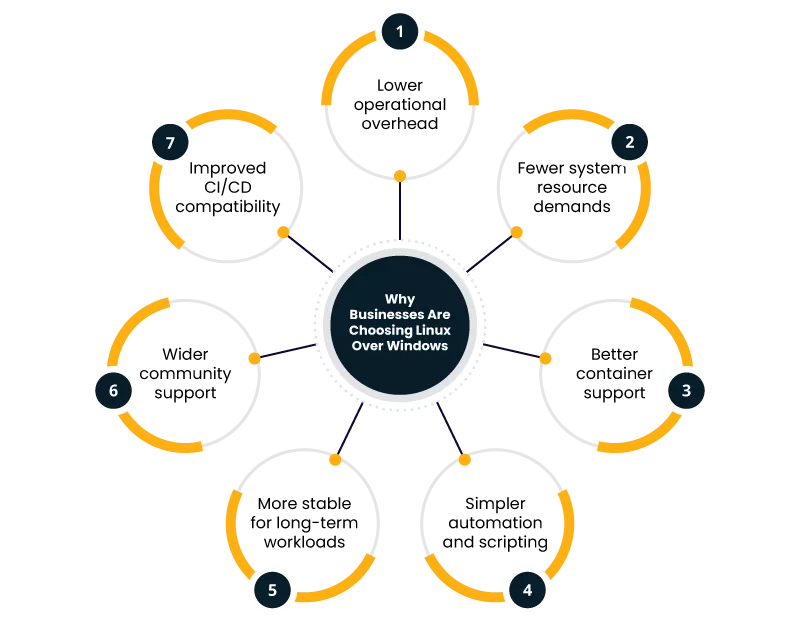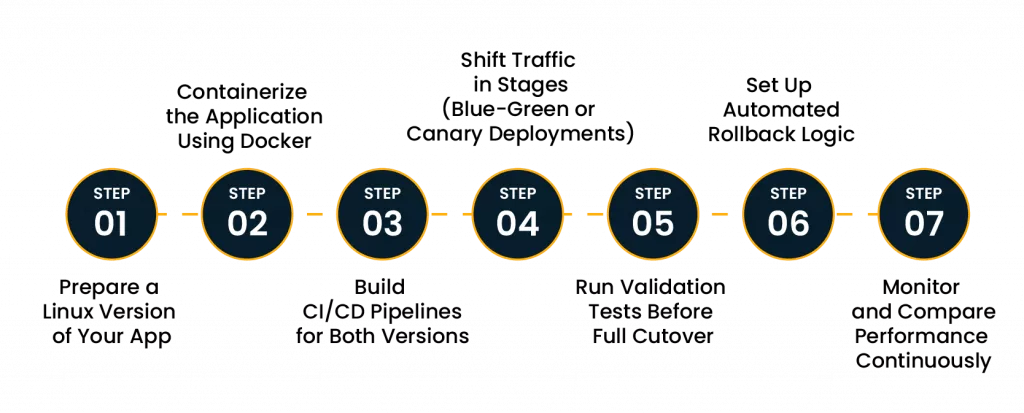A lot of teams are hitting a point where sticking with Windows and .NET Framework is holding things back.
Windows platform licensing keeps rising. .NET Framework is locked into Windows servers. Meanwhile, modern development favors open, scalable, cross-platform tools. That’s where .NET Core on Linux migration becomes an obvious next step. Replatforming isn’t about rebuilding everything from scratch. It’s about shifting your existing business logic onto a Linux-friendly runtime. You refactor what’s tied to Windows, use modern tools, and keep your application available the entire time.
In this blog, I’ll guide you through the right planning steps, show how to execute the migration clearly, walk through a real example, and explain how others have done it successfully—all while maintaining uptime.
What Replatforming Means Here
Replatforming means moving your existing .NET Framework app to a Linux-friendly runtime. You keep the core features. You only refactor what’s tied to Windows APIs. It differs from redevelopment, which rewrites everything from scratch. Practically, .NET replatforming helps teams save time while gaining cross-platform flexibility.
Why Businesses Are Choosing Linux Over Windows

- Lower operational overhead — Linux doesn’t require paid OS licenses.
- Fewer system resource demands — apps often run lighter on Linux.
- Better container support — Linux is the native environment for Docker and Kubernetes.
- Simpler automation and scripting — Bash and shell tools are more flexible for DevOps tasks.
- More stable for long-term workloads — fewer forced updates and reboots.
- Wider community support — active forums, open-source tools, and faster troubleshooting.
- Improved CI/CD compatibility — most pipelines are optimized for Linux environments.
These benefits support broader application modernization efforts and help teams move toward more resilient systems.
Prepare Before You Migrate
Getting ready is essential. Start with these steps:
- Audit your app
Note all Windows-specific dependencies like IIS, registry usage, or COM components.
- Check .NET version
Upgrade to .NET 4.8 if you’re still on older versions.
- Catalog third-party libraries
Replace Windows-only ones with cross-platform alternatives.
- Plan your deployment
Decide on Linux distro (e.g., Ubuntu 22.04 LTS).
- Ensure compliance
Make sure security patterns extend to Linux.
Here’s a handy table for clarity:
| Step | What to Do |
| Inventory Code | Identify Windows-only APIs, unsupported libraries, and registry access |
| Upgrade Framework | Move from older .NET versions to at least .NET Framework 4.8 |
| Replace Dependencies | Swap out libraries for cross-platform versions or open-source equivalents |
| Choose OS & Tools | Decide on Linux distro, container engine, monitoring setup |
| Plan CI/CD | Prepare build pipelines that work in Linux and Windows environments |
Use .NET replatforming and .NET Core on Linux migration naturally as you walk through these steps.
Tools That Support the Migration
These tools help reduce complexity:
- Porting Assistant for .NET – Analyzes your codebase for APIs that won’t work on Linux.
- .NET Upgrade Assistant – Updates project structure, dependencies, and references.
- AWS App2Container – Wraps your app into a container image.
- Docker – Builds portable containers for deployment.
- Prometheus or Grafana – Used to monitor container health and performance.
You can…
- Test
- Package
- Release your software across platforms
…using these tools without having to redo everything.
Step-by-Step Migration with Minimal Downtime

1. Prepare a Linux Version of Your App
- Install a clean Linux environment (such as RHEL 9 or Ubuntu 22.04 LTS).
- Use tools such as the.NET Upgrade Assistant. With it, you can port your.NET Framework codebase to.NET 8.
- Use cross-platform libraries like Serilog, IdentityServer, or REST-based APIs in place of Windows-only dependencies (like EventLog, WindowsAuth, and WMI).
This step makes sure it is compatible with Linux before deploying your program.
2. Containerize the Application Using Docker
Create a Dockerfile that uses a base Linux image:
FROM mcr.microsoft.com/dotnet/aspnet:8.0
WORKDIR /app
COPY . .
ENTRYPOINT ["dotnet", "YourApp.dll"]- Run the container locally with docker run. This will make sure it behaves the same way it did on Windows.
- If everything looks good, upload the image Docker Hub or Amazon ECR.
Containerization helps create consistent environments across
- Dev
- Staging
- Production
3. Build CI/CD Pipelines for Both Versions
- Use tools like GitHub Actions, GitLab CI, or AWS CodePipeline to:
- Build and test your app for Linux
- Package and publish Docker images
- Deploy automatically to staging and production environments
Sample GitHub Action workflow:
jobs:
build:
runs-on: ubuntu-latest
steps:
- uses: actions/checkout@v3
- name: Set up .NET
uses: actions/setup-dotnet@v3
with:
dotnet-version: '8.0.x'
- name: Build
run: dotnet buildCI/CD pipelines enforce repeatability and reduce human error during deployment.
4. Shift Traffic in Stages (Blue-Green or Canary Deployments)
- Run the Linux container next to your current Windows setup — think of it as the “blue” version running alongside the existing “green” one.
- Use Elastic Load Balancer (AWS) or Istio/Kubernetes to split traffic:
- Start with 5-10% going to Linux
- Monitor for errors, latency, and resource usage
- Gradually ramp up as confidence builds
Staging traffic this way prevents full cutovers until the new version is proven stable.
5. Run Validation Tests Before Full Cutover
- Run:
- Smoke tests
- Confirm the app starts, responds, and can hit APIs.
- Load tests
- Use tools like Apache JMeter or k6 to simulate real traffic.
- Latency monitoring
- Ensure response times stay within expected thresholds.
- Smoke tests
You can run these tests in parallel against both environments to compare behavior.
6. Set Up Automated Rollback Logic
- To track key metrics like CPU, memory, error rates, integrate monitoring tools like
- Amazon CloudWatch
- Datadog
- Prometheus
- Use thresholds or alarms to auto-trigger a rollback if:
- Error rate exceeds 5%
- Latency increases by more than 20%
- Container restarts spike unexpectedly
Automated rollback ensures your users never feel instability, even if something breaks in production.
7. Monitor and Compare Performance Continuously
- Use Grafana dashboards, ELK stack, or AWS X-Ray to visualize:
- API response times
- Throughput
- Dependency behavior
- System resource usage
- Compare these between old (Windows) and new (Linux) containers.
- Share reports with your engineering team daily for at least a week post-migration.
This ongoing comparison helps prove the success of the migration and catch regressions early.
These steps allow for a safe, gradual transition that reflects a real-world Windows to Linux replatforming strategy.
A Realistic Example: From Framework to Linux Containers
Let’s say your team manages a .NET Framework 4.7 Web API used for processing customer orders. It’s hosted on IIS, uses Windows Authentication, and logs to Windows Event Viewer.
Here’s how you replatform it:
- Upgrade to .NET Framework 4.8 to simplify compatibility.
- Use Porting Assistant for .NET to scan for unsupported APIs—like EventLog and System.Drawing.
- Replace Windows-only features. For logging, swap Event Viewer with Serilog, outputting to console or file.
- Make a new.NET 8 project. Stateless endpoints should be the first to undergo a migration.
- Start by building a Docker image using a Linux base like mcr.microsoft.com/dotnet/aspnet:8.0.
- Once it’s ready, push the image to Amazon ECR. Then, deploy it to AWS Fargate with an Application Load Balancer in front, leveraging the capabilities of AWS web services to ensure scalability, security, and seamless integration with your existing cloud infrastructure.
- Don’t switch everything over at once — start slow. Route about 10% of traffic to the new version using a blue-green setup.
- Keep tabs on things with CloudWatch or Prometheus. Watch for error spikes, slow responses, or anything unusual with container performance.
- Scale traffic up to 100% once stable. Decommission the IIS instance.
This approach achieves .NET Core on Linux migration with zero downtime and clearer observability at each step.
What to Do After the Move
Successfully migrating your app to Linux is a milestone, but ongoing maintenance and optimization are just as important. Here’s how to keep your system stable and future-ready:
1. Run Performance & Load Tests
Add tools like k6 or Apache JMeter to your CI/CD pipeline. Run tests after major code or dependency changes.
2. Apply Regular System Patches
- Ubuntu/Debian: apt update && apt upgrade
- RHEL/CentOS: dnf update
Automate patching with cron jobs or tools like Ansible.
3. Automate .NET Runtime Upgrades
Use versioned Docker images (dotnet/aspnet:8.0). Track .NET support timelines to avoid last-minute upgrades.
4. Keep Rollback Scripts Updated
Simulate failure scenarios. Test recovery using container snapshots or infrastructure backups.
5. Plan for Ongoing Modernization
Consider moving appropriate workloads to cloud-native AWS Lambda or dividing monoliths into microservices. Utilize performance data to guide choices.
6. Monitor Continuously
Set up dashboards for system health, performance, and deployment history.
Treat post-migration as an ongoing lifecycle. The effort ensures your .NET Core on Linux migration remains
- Reliable
- Secure
- Adaptable
Wrap‑Up!
Replatforming to Linux with .NET Core on Linux migration doesn’t need to be risky or disruptive. With a clean plan, the right tools, and a few safety nets, your app can shift to a more flexible environment, without users noticing any change. You gain control over costs, reduce operational complexity, and position your stack for the future.











